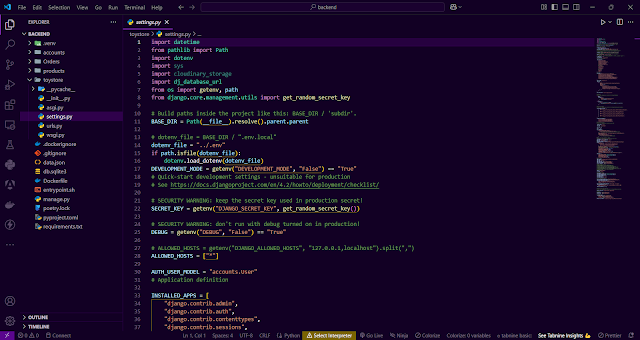1. Configuration in settings.py
To properly handle media files, you need to configure your Django settings.
Django 4.x / Django 5.x
There is no major difference in handling media files between Django 4 and Django 5. However, Django 5 has improved security and performance optimizations.
import os
from pathlib import Path
BASE_DIR = Path(__file__).resolve().parent.parent
# Media files configuration
MEDIA_URL = '/media/'
MEDIA_ROOT = BASE_DIR / 'media'
# Static files (CSS, JavaScript, Images)
STATIC_URL = '/static/'
STATICFILES_DIRS = [BASE_DIR / 'static']
STATIC_ROOT = BASE_DIR / 'staticfiles'
MEDIA_URL: Defines the URL path to serve media files.MEDIA_ROOT: Specifies the directory where uploaded media files are stored.
2. Creating a Model for Media Files
Django provides models.FileField and models.ImageField to handle file uploads.
from django.db import models
class UploadedFile(models.Model):
title = models.CharField(max_length=255)
file = models.FileField(upload_to='uploads/') # Stores in 'media/uploads/'
uploaded_at = models.DateTimeField(auto_now_add=True)
def __str__(self):
return self.title
3. Handling File Uploads in Forms
Django's built-in forms module makes it easy to handle file uploads.
from django import forms
from .models import UploadedFile
class UploadFileForm(forms.ModelForm):
class Meta:
model = UploadedFile
fields = ['title', 'file']
4. Creating Views for File Upload
You need to handle file uploads via a view.
from django.shortcuts import render, redirect
from .forms import UploadFileForm
from .models import UploadedFile
def upload_file(request):
if request.method == "POST":
form = UploadFileForm(request.POST, request.FILES)
if form.is_valid():
form.save()
return redirect('file_list')
else:
form = UploadFileForm()
return render(request, 'upload.html', {'form': form})
def file_list(request):
files = UploadedFile.objects.all()
return render(request, 'file_list.html', {'files': files})
5. Updating urls.py to Serve Media Files in Development
To serve media files during development, update your urls.py.
from django.conf import settings
from django.conf.urls.static import static
from django.urls import path
from .views import upload_file, file_list
urlpatterns = [
path('upload/', upload_file, name='upload_file'),
path('files/', file_list, name='file_list'),
]
if settings.DEBUG:
urlpatterns += static(settings.MEDIA_URL, document_root=settings.MEDIA_ROOT)
6. Creating Templates
upload.html
<form method="post" enctype="multipart/form-data">
{% csrf_token %}
{{ form.as_p }}
<button type="submit">Upload</button>
</form>
file_list.html
<ul>
{% for file in files %}
<li><a href="{{ file.file.url }}">{{ file.title }}</a></li>
{% endfor %}
</ul>
7. Handling Media in Production
In production, use cloud storage services like Amazon S3, Google Cloud Storage, or Azure Blob Storage instead of serving files from the Django server.
Example using django-storages with AWS S3:
- Install dependencies:
pip install django-storages[boto3]
for Django 4 this is the configuration
- Update
settings.py:# settings.py (Django 4.2 and earlier) DEFAULT_FILE_STORAGE = 'storages.backends.s3boto3.S3Boto3Storage' STATICFILES_STORAGE = 'storages.backends.s3boto3.S3Boto3Storage' AWS_ACCESS_KEY_ID = 'your_access_key_id' AWS_SECRET_ACCESS_KEY = 'your_secret_access_key' AWS_STORAGE_BUCKET_NAME = 'your_bucket_name' AWS_S3_REGION_NAME = 'your_region_name'
For Django 5 versions the settings are changed
# settings.py (Django 5.1 and later)STORAGES = {'default': {'BACKEND': 'storages.backends.s3boto3.S3Boto3Storage','OPTIONS': {'access_key': 'your_access_key_id','secret_key': 'your_secret_access_key','bucket_name': 'your_bucket_name','region_name': 'your_region_name',}},'staticfiles': {'BACKEND': 'storages.backends.s3boto3.S3Boto3Storage','OPTIONS': {'access_key': 'your_access_key_id','secret_key': 'your_secret_access_key','bucket_name': 'your_bucket_name','region_name': 'your_region_name',}}}
8. Differences in Django 4 and Django 5
| Feature | Django 4.x | Django 5.x |
|---|---|---|
| Media file handling | MEDIA_URL and MEDIA_ROOT required |
Same as Django 4.x |
| Security | Basic security improvements | Enhanced security policies for file uploads |
| Performance | Optimized storage but no major changes | Further performance optimizations |
| ASGI Support | Supported | Improved ASGI support |
Conclusion
- For development, use
MEDIA_URLandMEDIA_ROOT. - For production, use django-storages with AWS S3 or another cloud provider.
- Django 5 improves security but does not significantly change media handling.



0 Comments